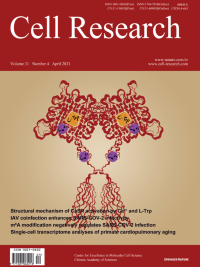
Advanced Search
Submit Manuscript
Advanced Search
Submit Manuscript
Volume 31, No 4, Apr 2021
ISSN: 1001-0602
EISSN: 1748-7838 2018
impact factor 17.848*
(Clarivate Analytics, 2019)
Volume 31 Issue 4, April 2021: 415-432 |
Single-cell transcriptomic atlas of primate cardiopulmonary aging
Shuai Ma1,2,3 , Shuhui Sun1,4 , Jiaming Li5,6,7 , Yanling Fan5,6,7 , Jing Qu2,3,7 , Liang Sun8,9 , Si Wang1,3,10 , Yiyuan Zhang4 , Shanshan Yang10 , Zunpeng Liu2,7 , Zeming Wu2,7 , Sheng Zhang4,7 , Qiaoran Wang5,6,7 , Aihua Zheng7,11 , Shuguang Duo12 , Yang Yu13,14 , 4, Juan Carlos Izpisua Belmonte15 , Piu Chan10 , Qi Zhou2,3,7 , Moshi Song2,3,7,* , Weiqi Zhang5,6,7,* , Guang-Hui Liu1,3,4,7,10,*
1State Key Laboratory of Membrane Biology, Institute of Zoology, Chinese Academy of Sciences, Beijing 100101, ChinaAging is a major risk factor for many diseases, especially in highly prevalent cardiopulmonary comorbidities and infectious diseases including Coronavirus Disease 2019 (COVID-19). Resolving cellular and molecular mechanisms associated with aging in higher mammals is therefore urgently needed. Here, we created young and old non-human primate single-nucleus/cell transcriptomic atlases of lung, heart and artery, the top tissues targeted by SARS-CoV-2. Analysis of cell type-specific aging-associated transcriptional changes revealed increased systemic inflammation and compromised virus defense as a hallmark of cardiopulmonary aging. With age, expression of the SARS-CoV-2 receptor angiotensin-converting enzyme 2 (ACE2) was increased in the pulmonary alveolar epithelial barrier, cardiomyocytes, and vascular endothelial cells. We found that interleukin 7 (IL7) accumulated in aged cardiopulmonary tissues and induced ACE2 expression in human vascular endothelial cells in an NF-κB-dependent manner. Furthermore, treatment with vitamin C blocked IL7-induced ACE2 expression. Altogether, our findings depict the first transcriptomic atlas of the aged primate cardiopulmonary system and provide vital insights into age-linked susceptibility to SARS-CoV-2, suggesting that geroprotective strategies may reduce COVID-19 severity in the elderly.
https://doi.org/10.1038/s41422-020-00412-6